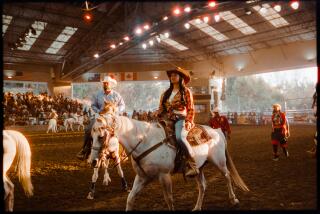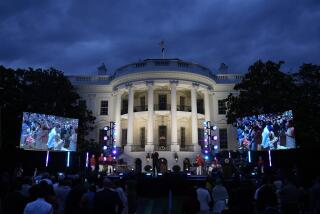Celebration of Juneteenth Brings Black History to Life
- Share via
Keith Anderson chose to celebrate Juneteenth at the Autry Museum of Western Heritage in Griffith Park.
Sometimes called the African-American Fourth of July, Juneteenth commemorates June 19, 1865, the day an American general rode into Galveston, Texas, and announced the end of slavery.
In fact, the Emancipation Proclamation freeing the slaves in the Confederate states had been signed by President Lincoln 2 1/2 years earlier. But the news had been slow to reach Texas, whether by accident or design on the part of Texas farmers who wanted unpaid black workers to bring in one more cotton crop.
Late or not, the news caused jubilation among the African Americans in Texas who now knew they were free.
Thirty-eight-year-old Anderson, who lives in Pasadena, has marked the holiday since he was child. “My mother always wanted us to celebrate Juneteenth,” he said. He remembered the holiday as a time to visit family in Texas and Arkansas, where it is widely celebrated with reunions that almost always include barbecue, red soda pop and reflection on the black experience in America. In Texas, Juneteenth is a state holiday.
*
On Saturday, Anderson was introducing the holiday to a new generation. With him were four young men, who were enthralled by a half dozen members of the New Buffalo Soldiers, a highlight of the Autry Juneteenth program.
“Are these your sons?” Anderson was asked. “No, they’re not my sons, but they’re all my boys,” he replied.
Admiring the 19th century rifles, sabers and other equipment of the New Buffalo Soldiers, modern-day African Americans who impersonate the U.S. Army’s first black cavalry regiments, were Anderson’s charges--Angel, Nathan, Darrell and Mark.
Anderson, who describes himself as their mentor, explained that he could not reveal their last names because they are with Five Acres, a nonprofit organization in Altadena that provides services to minors who are wards of the court.
Later, the boys, who range in age from 11 to 14, heard actor Tim Russ read the Emancipation Proclamation to a hushed audience of 100 people of many races and ethnicities.
Russ is probably best known for his role as the Vulcan Tuvok on the TV show “Star Trek Voyager.” Before his moving rendition of the words that declared an end to slavery, Russ observed, “We’ve come a long way--from emancipated slaves to Vulcans in space.”
Trying to suggest the conditions under which the original Buffalo Soldiers lived, the New Buffalo Soldiers had pitched their tent on the museum’s south lawn.
*
As founder John Mapp of Glendale explained, the group was inspired in part by the film “Glory.”
According to Mapp, a neonatalogist, 180,000 African Americans fought in the Civil War, but none were members of the regular Army.
“The group we portray is the 10th Cavalry,” he said. “They were formed after the end of the Civil War, in 1866, by an act of Congress that created two regiments of black cavalry, with white officers.” Like the 9th Cavalry, the other mounted black regiment created by the act, the 10th was part of the regular U.S. Army.
“This was such a landmark,” Mapp said.
There is much speculation as to how the Buffalo Soldiers got their unusual name (a buffalo is their official logo).
Most people believe it was given them by Native Americans, against whom they sometimes fought.
Mapp is not surprised that the Plains Indians named the black soldiers after the buffalo.
“These were mainly former slaves,” Mapp said. “This was the first time they could defend themselves, and they became ferocious fighters. The Indians admired their courage and their valor. And they also thought the hair on their heads resembled the hair between the horns of the buffalo.”
Clyde Phillips, a counselor at Orange Coast College in Costa Mesa, said one of the reasons he became a New Buffalo Soldier is that it allows him to broaden the average student’s understanding of both black and American history.
“Most of the students can tell you that blacks were slaves, and that’s about it.”
Phillips also thinks the original Buffalo Soldiers are good role models for today’s children. Too many are enamored with athletes and musicians, in his view. Parents should be a child’s first heroes, he says, and their other heroes “should be people who stand for something, something greater than themselves.”
The Autry program also included a brief history of African Americans and the West. Rick Moss, curator of history at the California African American Museum in Exposition Park, talked about such little-known black Westerners as “Negro Bob,” who apparently jumped a ship visiting what is now California in 1816 to become the first English-speaking African American to settle in the area, near Santa Barbara (the many other African Americans who lived in what is now California spoke Spanish).
Moss also talked about Allensworth, near Tulare, the only all-black town in California. Like black communities in Texas and elsewhere, it was a place where blacks could escape harassment and govern their own lives. Founded in 1908, it is now a state park.
More to Read
Sign up for The Wild
We’ll help you find the best places to hike, bike and run, as well as the perfect silent spots for meditation and yoga.
You may occasionally receive promotional content from the Los Angeles Times.






